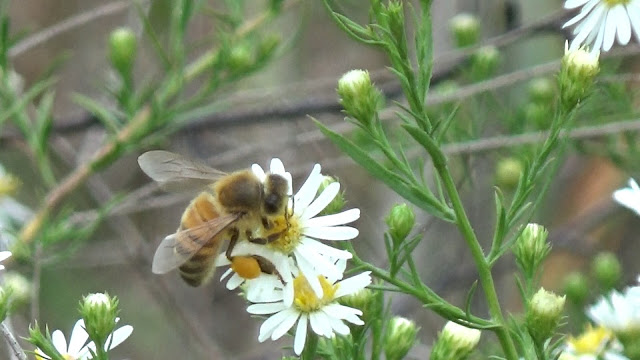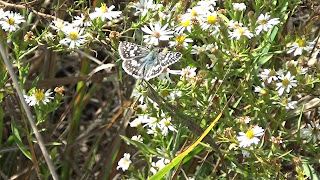Flies came to the asters in droves! Here are the brilliantly colored Secondary Screwworm Flies (Cochliomyia macellaria):
Tuesday, November 30, 2021
Aster World, Part 6: Bright Iridescent Flies
Monday, November 29, 2021
Aster World, Part 7: Beetles
Aster-loving beetles came in multiple shapes and colors!
A Black Blister Beetle munched on the flowers, October 6, 2021:
Epicauta pensylvanicus has an affinity for asters and other plants in the Sunflower Family.
Two brightly colored beetles visited the backyard asters at the same time:
The red one is a Convergent Lady Beetle (Hippodamia convergens), and the yellow one is a Spotted Cucumber Beetle (Diabrotica undecimpunctata).
What are they looking for on the asters?
The Lady Beetle may be looking for tiny insects to eat, though she may also grab some pollen to supplement her diet.
The Cucumber Beetle is a vegetarian and may want to eat the flowers or foliage.
If she fills up on asters she may leave our garden vegetables alone!
The Lady Beetle, on the other hand, is welcome in our garden!
In September 2021, the asters were covered with Leatherwing Beetles, Chauliognathus pennsyvanicus:
Sunday, November 28, 2021
Aster World, Part 8: Crane Flies
Here are some Crane Flies that came to visit the asters in our backyard:
Most people have seen the sizeable crane flies, that look like giant mosquitoes. These are a smaller species, in the family Limoniidae, and possibly in the sub-genus Geranomyia--one of three groups of crane flies that have long mouthparts for feeding on flowers. Though these fast-moving insects make for blurry images, we can get brief glimpses of their long proboscises. These remarkable flies bob up and down rapidly while perching and feeding--a lot to do all at once!
Saturday, November 27, 2021
Aster World, Part 9: Clouded Sulphurs
Swirling around the asters this year were clouds of Clouded Sulphurs.
There may be other species of sulphur butterflies mixed in. They not only resemble Clouded Sulphurs but may hybridize with them.
The caterpillars feed on plants in the legume family. We have lots of those among the wildflowers on our land. In addition, an alfalfa field is just across the fence!
Friday, November 26, 2021
Aster World, Part 10: Bees
Common Eastern Bumblebees (Bombus impatiens) are the last bumblebees still flying in the fall, while Hairy Asters (Symphyotrichum pilosum) are among the last wildflowers to bloom.
Here the two find each other in our backyard:
Two-spotted Bumblebees (Bombus bimaculatus) were the first bumblebees we saw this season (they were on the Foxglove Penstemon blooming in the spring). The Common Eastern Bumblebees (Bombus impatiens) were the last, coming to the asters for nectar and pollen.
Bumblebees are the most important pollinators.
Honeybees are not native to the US, but many have escaped from managed hives and now make up part of the wild population. Here is a feral Western Honeybee visiting Hairy Asters in our Creek Field in late September 2021. Note the yellow pollen ball on her leg:
Here is that bee in action, joined by a sister:
Here is another worker-bee carrying a pollen ball on her leg as she visits volunteer Hairy Asters in our backyard (October 6, 2021):
European honeybees have been known to push out our native bees. But from what I've seen, when it comes to Hairy Asters, there's more than enough for everyone.
Wednesday, November 24, 2021
Aster World, Part 11: Flower Flies
Next to bees, flies are the most important pollinators!
There is a special category of flies called "Flower Flies," famiily Syrphidae.
Many species of Flower Fly are bee-mimics.
 |
| Flower Fly Dioprosopa clavata on Symphyotrichum pilosum Bird Runner Wildlife Refuge McDowell Creek, Geary Co., KS October 2021 |
But this fall a Flower Fly that is a wasp-mimic, Dioprosopa clavata, visited our volunteer Hairy Asters.
Such a tiny fly! Such delicate markings!
Look at that "wasp-waist":
 |
| Look closely at the stems and you can see why Symphyotrichum pilosum is called "Hairy Aster." |
The wasp-waist fooled me at first, and I thought this visitor was a tiny wasp. But bugguide.net corrected my mistake. I should have noticed the huge eyes. They say "fly," not "bee" or "wasp."
Flower Flies come in many sizes. Eristalis stipator is about ten times the size of D. clavata and is a bee mimic. In fact, I fell for the bee act when I first encountered this species years ago. But this year I knew what it was!
Here is E. stipator, resembling a honeybee and visiting our volunteer asters on October 15, 2021:
Monday, November 22, 2021
Aster World, Part 12: Wasps
This handsome wasp is a member of the genus Polistes--the "Umbrella Paper Wasps." Polistes are large social wasps that share a paper nest that hangs upside-down, by a stalk. Sterile female workers are the first to emerge in the summer. Fertile females and males appear late in the season.
This is a male (that curled antenna is the give-away).
Here he is in action, on Hairy Asters (Symphyotrichum pilosum).
Many native wildflowers have already gone to seed. This late-emerging wasp needs nectar to fuel his search for a fertile female. Thank goodness for late-blooming asters!
Sunday, November 21, 2021
Aster World, Part 13: Common Checkered Skipper and Snout Moths
A gorgeous Common Checkered Skipper (Pyrgus communis) came to nectar on the Hairy Asters (Symphyotrichum pilosum) that volunteered in our backyard. The blue-gray color indicates a male of the species.
Here is that little guy in action:
One species of Snout Moth that featured prominently on the volunteer asters on our land was the Two-spotted Herpetogramma (Herpetogramma bipunctalis):
The thumbnail shows the two spots on the dorsum that give the species its name. Their wings make a shimmering robe. And I love their tinker-toy legs! Some of these clips clearly show the asters' hairy stems and leaves that give this wildflower species its name--Hairy Asters (Symphyotrichum pilosum).
Aster World, Part 14: More Moths
This moth's common name is "Dingy Cutworm Moth," so named for the non-descript larva. But the adult is boldly patterned, clearly not "dingy."
In fact, an entomologist with bugguide.net says a better common name would be
"Bright-striped Dart." I agree!
Here is the Chickweed Geometer, a moth whose larvae eat wetland plants, such as chickweed and smartweed.
 |
| Haematopis grataria, Chickweed Geometer, on Hairy Asters, October 2021 |
This one is a male as can be told by the lush bristles on his antennae!
He is part of the family of Geometrid Moths (Geometridae), or "Earth Measurers," so named for their larvae's method of locomotion. The larvae advance by gathering themselves up into a loop and then extending forward, earning the common name of "inch worm." Each "step" is supposedly one inch.
Here is a grass moth--long and thin to blend in with the blade of a grass. This one is yet another member of the Crambid Snout Moth family--so named for the extended mouth parts that look like a "snout." (S)he doesn't seem interested in sharing asters with a neighboring fly. Note that two-toned proboscis!
Now for a member of yet another family, the Plutellidae, or Diamond-back Moths. Check out that tail fin!
Plutella xylostella, a Diamond-back Moth,
nectaring on Hairy Asters, October 2022.
Here (s)he is in action:







